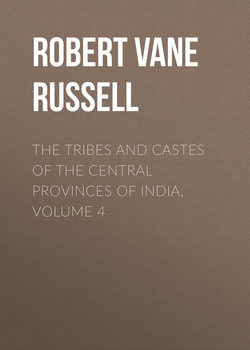Читать книгу The Tribes and Castes of the Central Provinces of India, Volume 4 - Robert Vane Russell - Страница 56
Part II
Articles on Castes and Tribes
Kumhār—Yemkala
Vol. IV
Kurmi
17. Ceremonies after birth
ОглавлениеWhen a boy is born the father’s younger brother or one of his friends lets off a gun and beats a brass plate to proclaim the event The women often announce the birth of a boy by saying that it is a one-eyed girl. This is in case any enemy should hear the mention of the boy’s birth, and the envy felt by him should injure the child. On the sixth day after the birth the Chhathi ceremony is performed and the mother is given ordinary food to eat, as described in the article on Kunbi. The twelfth day is known as Barhon or Chauk. On this day the father is shaved for the first time after the child’s birth. The mother bathes and cuts the nails of her hands and feet; if she is living by a river she throws them into it, otherwise on to the roof of the house. The father and mother sit in the chauk or space marked out for worship with cowdung and flour; the woman is on the man’s left side, a woman being known as Bāmangi or the left limb, either because the left limb is weak or because woman is supposed to have been made from man’s left side, as in Genesis. The household god is brought into the chauk and they worship it. The Bua or husband’s sister brings presents to the mother known as bharti, for filling her lap: silver or gold bangles if she can afford them, a coat and cap for the boy; dates, rice and a breast-cloth for the mother; for the father a rupee and a cocoanut. These things are placed in the mother’s lap as a charm to sustain her fertility. The father gives his sister back double the value of the presents if he can afford it. He gives her husband a head-cloth and shoulder-cloth; he waves two or three pice round his wife’s head and gives them to the barber’s wife. The latter and the midwife take the clothes worn by the mother at child-birth, and the father gives them each a new cloth if he can afford it. The part of the navel-string which falls off the child’s body is believed to have the power of rendering a barren woman fertile, and is also intimately connected with the child’s destiny. It is therefore carefully preserved and buried in some auspicious place, as by the bank of a river.
In the sixth month the Pasni ceremony is performed, when the child is given grain for the first time, consisting of rice and milk. Brāhmans or religious mendicants are invited and fed. The child’s hair and nails are cut for the first time on the Shivrātri or Akti festival following the birth, and are wrapped up in a ball of dough and thrown into a sacred river. If a child is born during an eclipse they think that it will suffer from lung disease; so a silver model of the moon is made immediately during the eclipse, and hung round the child’s neck, and this is supposed to preserve it from harm.
